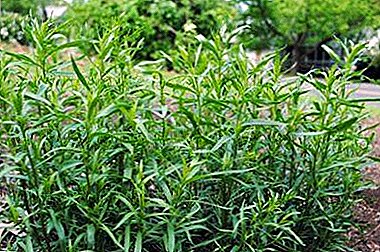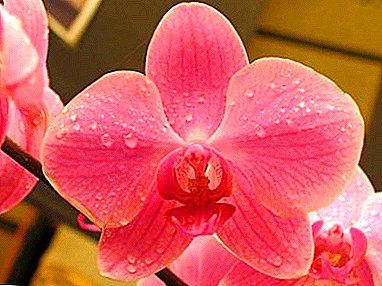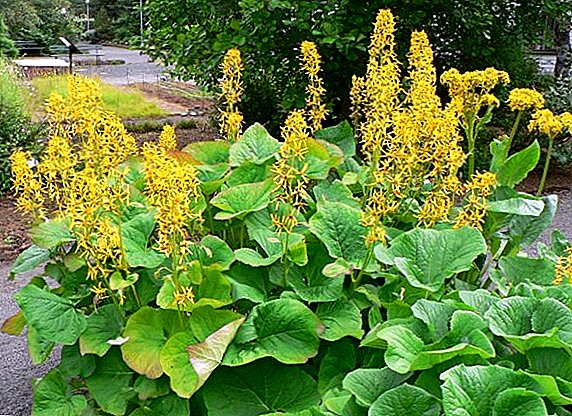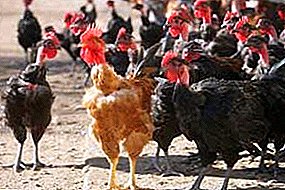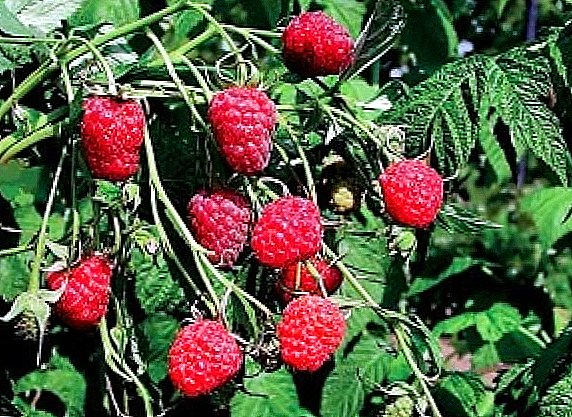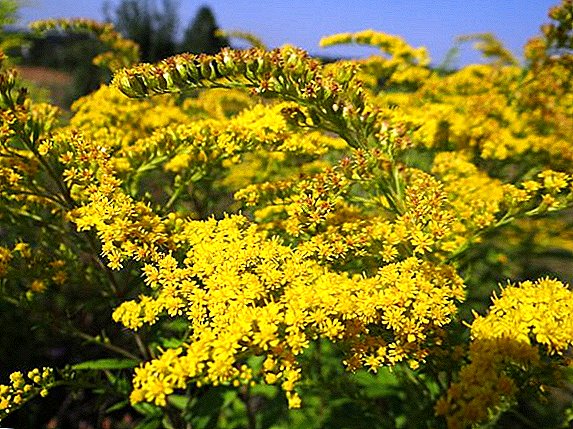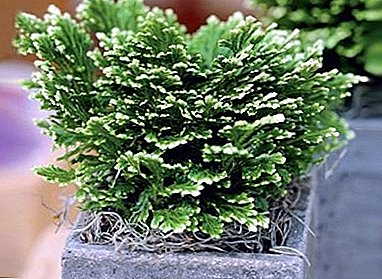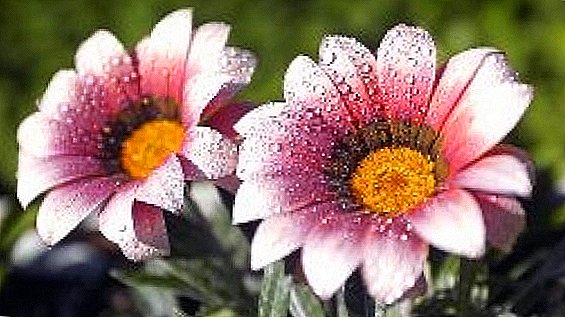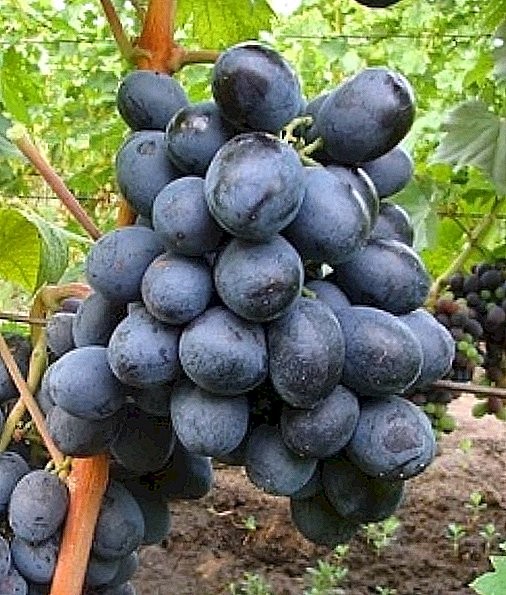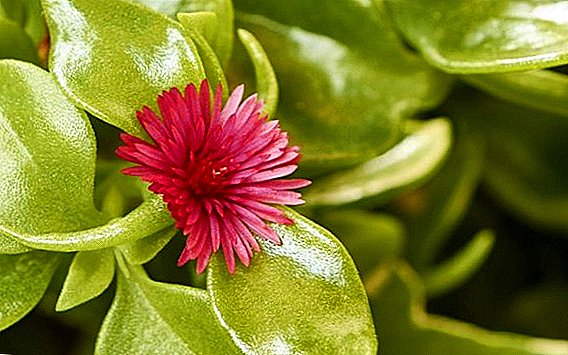 One of the main problems that lovers of indoor plants have to face is the inability to create indoors a humidity level sufficient for the inhabitants of the tropics. An excellent compromise in this sense is drought-resistant succulents, especially since there are very beautiful specimens among them. One of them, of course, is aptenia (Aptenia), which will be discussed in this review.
One of the main problems that lovers of indoor plants have to face is the inability to create indoors a humidity level sufficient for the inhabitants of the tropics. An excellent compromise in this sense is drought-resistant succulents, especially since there are very beautiful specimens among them. One of them, of course, is aptenia (Aptenia), which will be discussed in this review.
Plant description
The homeland of aptenia, also known as the Mesembryantemum, is the southern part of the Black Continent (KwaZulu-Natal and the Eastern Cape Province of South Africa), but at present this semi-shrub ground cover plant is widely used to decorate flowerbeds in countries known to every tourist such as Turkey and Egypt. In Europe, some types of aptenia have recently begun to grow at home as a houseplant, but this flower has not yet received wide distribution and is quite rare on the market.
Did you know? The name "mesembryantemum" for a succulent was coined by scientists at the end of the 17th century by combining two Greek words - "μεσημββα" (midday) and "ἄνθεμον" (flower). The fact is that in the wild nature, blooming aptenia opens its buds only in the middle of the day when the sun rises high enough (in Russia such flowers are called semi-daylings or sunbeds).
According to the botanical classification, the succulent belongs to the order of centroserenal (pink flowers), the family of aizids. As the name implies, the foliage does not discard the plant with the change of season (the word "αειζωον", which gave the name to the family, is translated from Greek as evergreen). Aptenia grows very quickly, gathering up to 500 mm in length in a year, and depending on the composition of the soil it can develop as an annual or as a perennial.  Morphological characteristics of aptenia:
Morphological characteristics of aptenia:
| Type of stem | Spreading, creeping (ampel) |
| The structure and shape of the stem | Fleshy, dense, tetrahedral |
| Maximum stalk length | 100 cm |
| Stem color | Bright green, as it grows grayish |
| The shape and structure of the leaves | Lanceolate, dense, oval or heart-shaped, with small papillary outgrowths. Location opposite, scapes short |
| Leaf size | Up to 60 mm |
| The roots | Very powerful |
| Flowers | Small, up to 20 mm, bright red, pink or white, located in the axils of the leaves at the top of the stem. With good care, flowering is very lush, usually occurs in spring or summer |
| Fruit | Multi-chamber seed capsule |
Types of drugs
Modern science knows four types of aptenia:
- serdtselistnaya (Aptenia cordifolia);
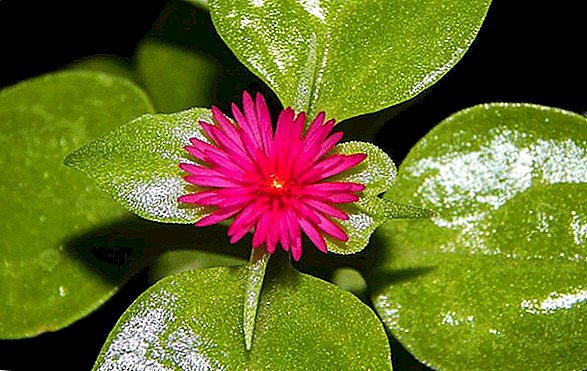
- white flowers (Aptenia geniculiflora);

- lanceolistus (Aptenia lancifolia);
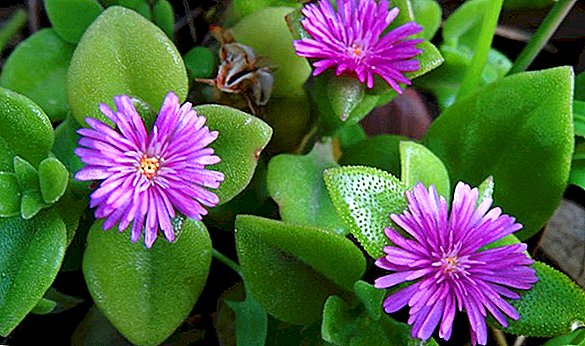
- Hekelia (Aptenia haeckeliana).
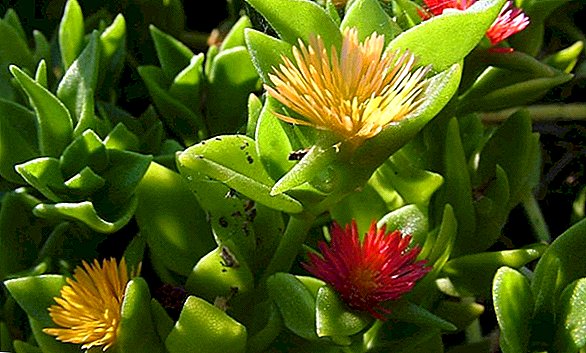
However, each species has its own subspecies, in addition, there are several hybrid forms that have been developed in recent years by amateur breeders. Cardiac aptelium is the most common representative of the genus. This succulent can reach 25 cm in height, but it looks much more effective in pots, in this case its lush and thin shoots hang picturesquely 50-60 cm, in the period from April to August it is covered with a large number of bright flowers of purple, burgundy or lilac color. The leaves of this species are monochromatic green in color and reach a length of 25 mm, flowers have a diameter of up to 15 mm.
Did you know? Cardiovascular aptenia has some medicinal properties, but South African tribes believe that this flower can also protect from evil forces and, conversely, attract good spirits. To use this property of the plant, the aborigines make amulets and amulets of it.
Aptelium variegated (variegated) is a type of Aptelium cordifolia, the Latin name is Aptenia cordifolia variegata. Its stems are slightly shorter, and the leaves are smaller than those of the classical type, but the main feature of the variegated form is the presence of a decorative light yellow border on each leaf. Another type of cardiovascular aptenia has leaves with variegated inclusions located all over the surface of the plate. The lanceolate aphenia has bright green creeping shoots reaching 800 mm in length.  As the name implies, the shape of the leaves is lanceolate, elongated. By structure, they are similar to the leaves of the money tree, but a bit lighter and brighter. The flowers are red or pink, the outer petals are longer than the inner ones. The variety of the Mesembryantemum, named after the German naturalist Ernest Heinrich Haeckel, differs from its “relatives” primarily in the color of flowers: in this species they are not red, like most others, and the yellow ones are very light, almost white on the outside and more saturated closer. to the center of the corolla.
As the name implies, the shape of the leaves is lanceolate, elongated. By structure, they are similar to the leaves of the money tree, but a bit lighter and brighter. The flowers are red or pink, the outer petals are longer than the inner ones. The variety of the Mesembryantemum, named after the German naturalist Ernest Heinrich Haeckel, differs from its “relatives” primarily in the color of flowers: in this species they are not red, like most others, and the yellow ones are very light, almost white on the outside and more saturated closer. to the center of the corolla.
Learn how to grow lithops at home.
Among the most interesting hybrids of the plant is the white-flowered aptenia (Aptenia geniculiflora), which can be admired in the Nikitsky Botanical Garden near Yalta. This succulent flowers have very thin snow-white petals, curling to the rim in the form of a kind of crown.
Growing conditions
To grow a mesembryanthum as an indoor plant, the standard conditions necessary for all succulents are necessary.
Lighting
Aptenia is a light-loving plant, but it needs good lighting not only for normal development, but also as a necessary condition, without which the succulent will not bloom. Nevertheless, the flower still needs to be protected from direct sunlight. The best place for the plant is the windows facing east.  The western direction is a little less, but as an alternative can be considered. On the south windows, the flower risks getting burns from direct sunlight, but if you provide light shading or scatter light with the help of blinds, the problem can be easily solved.
The western direction is a little less, but as an alternative can be considered. On the south windows, the flower risks getting burns from direct sunlight, but if you provide light shading or scatter light with the help of blinds, the problem can be easily solved.
Important! To ensure the most intense flowering, the level of illumination for the mesembryanthum with the beginning of spring is recommended to be increased with the help of artificial lighting. For this, lamps with a minimum power of 50 W are used.
On the north side or in the shade of aptenia, it loses its decorativeness, its stems become long and weak, the leaves shrivel and fall, the flowers do not bloom. In the summer, the pot can be taken out on the open balcony or even dug in a flower bed. Under the influence of constantly moving air masses, the plant is much less susceptible to sunburn than on an overheated window sill at a closed window.
Air temperature
In order for an aptenia to develop normally, its annual cycle must be divided into two periods - the phase of growth and the phase of rest. This secret will help to achieve abundant flowering of succulent. The main difference in the care of the plant during these two periods is in the temperature regime.  The optimal indicators of air temperature for a plant in different phases of its development are shown in the table:
The optimal indicators of air temperature for a plant in different phases of its development are shown in the table:
| Phase | Calendar period | Optimum air temperature |
| Growth | october - february | + 22 ... + 25 ° С |
| Peace | March - September | + 5 ... + 8 ° С |
Air humidity
Dry air is not a problem for aptenia, moreover, excessive moisture is contraindicated for a flower. However, in the immediate vicinity of the heating devices, the pot should not be placed, since such intense heat, especially in the winter period, suffers very poorly. Spraying and rinsing the leaves with water also doesn’t like a flower; such a procedure can be carried out as an exception to removing dust from the leaves, but even this manipulation is best done with a soft and dry cloth.
Check out the description of the popular succulent plant for home.
If in the autumn-winter period the mesembryantemum at the battery begins to turn yellow, stretch out or drop the leaves, this may indicate a flower's reaction to overdried and overheated air, but in this case the plant should not be moistened, but transferred to a cooler place.
Home care
Caring for aptenia cannot be called complex, however, like all ornamental flowering plants, this succulent requires compliance with certain requirements, without which abundant and prolonged flowering should not be expected. 
Watering
Watering the succulent, which is in the activity phase, is necessary as the upper layer of the earthy coma dries out. The frequency and intensity of watering should be strictly balanced, because the flower reacts about the same to waterlogging and to drying out approximately the same way - the leaves shrivel, wither and fall. Watering is carried out at the root and on the entire outer surface of the earthen coma.
Important! Potted plants should not be watered with cold water! Fluid temperature must always be at or several degrees above air temperature.
Water for irrigation can be used rain, thawed, well, spring, river or pre-treated. If water is taken from the aqueduct, it must at least be kept in an open container for several days and use the top layer removed from the sediment. In the resting phase, the intensity of irrigation is minimized, during this period it is enough to water the plant 2-3 times a month so that the roots do not completely dry out.
Top dressing
In nature, succulents usually grow on rather scanty soils dominated by sand and stones, and the fertile layer is minimal. For this reason, abusing such plants at home should not be abused. A high amount of nitrogen in the soil is especially dangerous for aptenia; the flower starts to rot from this, stops flowering and may even die.  In order not to be mistaken with the dosage, it is best to use special blends for succulents, presented in flower shops (Agricola, Stimulus, Gileya, Planton, Fartis, etc.) as fertilizers. In such preparations, nitrogen, phosphorus, potassium, calcium, magnesium, fluorine and other components important to the plant are presented in optimal proportion.
In order not to be mistaken with the dosage, it is best to use special blends for succulents, presented in flower shops (Agricola, Stimulus, Gileya, Planton, Fartis, etc.) as fertilizers. In such preparations, nitrogen, phosphorus, potassium, calcium, magnesium, fluorine and other components important to the plant are presented in optimal proportion.
Also read about how to care for succulents at home.
During the period of active growth of fertilization, fertilization should be carried out no more than once a month, and during the rest period, fertilizing should be completely stopped.
Pruning
Since morphologically aptenia consists of numerous and rapidly stretching stems, spreading over the soil or hanging from pots, it needs regular formative pruning to preserve the decorativeness of the bush. The best time for pruning is autumn, when the plant has faded and is preparing to go into the resting phase. If the shortening of the shoots is carried out in the spring, the procedure, no matter how easy it is transferred, will serve as a certain stress for the flower, which means that the budding will start much later.  An exception to this rule is the situation when, due to an improperly organized resting phase, the bush dropped leaves after winter, or its shoots became very long. In this case, the stems that have lost their decorative effect should be cut off; new ones will soon appear in their place. If this procedure is done in February, by the middle of spring the updated succulent may well bloom.
An exception to this rule is the situation when, due to an improperly organized resting phase, the bush dropped leaves after winter, or its shoots became very long. In this case, the stems that have lost their decorative effect should be cut off; new ones will soon appear in their place. If this procedure is done in February, by the middle of spring the updated succulent may well bloom.
Important! The more often the shoots are cut from aptenia, the faster and more magnificent it will grow.
Transfer
It is necessary to transplant fast-growing aptenia every year, otherwise the powerful and strong roots of the mesembryanthemma fill the entire pot, and the plant loses the ability to develop normally. Since the succulent transports quite easily, it is best done in the spring, at the stage of removing a flower from the resting phase. The root system of aptenia is designed to search for water at great depths, so the pot for the plant must be selected high.  However, with each subsequent transplant, the size of the new pot should be only a few centimeters larger and in diameter, otherwise the plant will need much more time to “get comfortable” at the new location. As a land mixture is best to use ready-made substrate for cacti and succulents. If you wish to prepare the soil yourself, you should mix the sod land with coarse river sand, adding some charcoal to the composition to be disinfected.
However, with each subsequent transplant, the size of the new pot should be only a few centimeters larger and in diameter, otherwise the plant will need much more time to “get comfortable” at the new location. As a land mixture is best to use ready-made substrate for cacti and succulents. If you wish to prepare the soil yourself, you should mix the sod land with coarse river sand, adding some charcoal to the composition to be disinfected.
Important! Watering the plant after transplantation can be no earlier than three days, and with fertilizer is better to wait 1-2 months.
Put a thick drainage layer on the bottom of the prepared pot, then pour a small amount of prepared soil on top, place the plant carefully removed from the old pot together with the earthy clod in the center of the pot, then carefully pour the required amount of fresh earth around the pot circumference and tamp it well and, if necessary, add a little more soil mix.
Breeding
You can get a young adenia plant at home in two ways - by growing seeds or rooting cuttings. The vegetative breeding method is considered to be faster and more reliable; in addition, it is good in that it guarantees the initial maternal species, which is especially important for hybrid varieties whose seeds do not inherit the parental traits.  As the cuttings, you can use fragments of stems, cut during aptenia forming a pruning. Putting them into the water for rooting, as many inexperienced flower growers do, cannot, on the contrary, dry the cuttings for 10-12 hours before planting, leaving them in a place protected from direct sunlight (this rule applies to all succulents). It is best to germinate cuttings in a substrate consisting of 1 part of earth for succulents and 2 parts of river sand or vermiculite.
As the cuttings, you can use fragments of stems, cut during aptenia forming a pruning. Putting them into the water for rooting, as many inexperienced flower growers do, cannot, on the contrary, dry the cuttings for 10-12 hours before planting, leaving them in a place protected from direct sunlight (this rule applies to all succulents). It is best to germinate cuttings in a substrate consisting of 1 part of earth for succulents and 2 parts of river sand or vermiculite.
The prepared soil mixture should be poured into shallow containers and well moistened, then carefully bury the cuttings in the substrate and leave them to rooting. It is not necessary to cover the plants with a film, it is enough to periodically moisten the soil surface with water from a spray bottle. When the cutting starts to let young leaves and shoots, it can be transplanted to a permanent place.
Important! It is best to chop aptenia in the fall, in this case in the spring the young plant may already bloom.
Sowing seeds of mesembryantmum is a rather complicated procedure. Due to the very low germination of the seeds of this succulent should not be embedded in the soil, and spread on its surface. The substrate for this is best used the same as for rooting cuttings, but you can restrict the usual sand or vermiculite. Having laid the seeds on a wet substrate, it should be covered with a film or glass and placed in a well-lit place with a temperature of + 21 ... + 25 ° С. After the appearance of the first shoots (the procedure may take a month or even more), the protection must be removed.  When the length of young plants reaches 50 mm, they should be carefully transplanted into a more suitable soil - a substrate for succulents or a mixture of equal parts of turf, leaf soil and sand. At this stage, the air temperature must be reduced to + 16 ... + 18 ° С and such conditions will be maintained until the seedlings finally get stronger. Watering young seedlings is often necessary, but very dosed, because for weak roots excess moisture is especially dangerous.
When the length of young plants reaches 50 mm, they should be carefully transplanted into a more suitable soil - a substrate for succulents or a mixture of equal parts of turf, leaf soil and sand. At this stage, the air temperature must be reduced to + 16 ... + 18 ° С and such conditions will be maintained until the seedlings finally get stronger. Watering young seedlings is often necessary, but very dosed, because for weak roots excess moisture is especially dangerous.
Did you know? Surprisingly, the record for drought tolerance among plants are not succulents, but algae. So, for example, bubble fucus, being on land, is able to “shrink” 10 times compared to its usual state, after which, once again in the water element, it recovers almost instantly. Interestingly, this same plant has a unique frost resistance, withstanding freezing to -60 ° C.
Difficulties in growing
Diseases and pests rarely affect succulent, but certain difficulties associated with gardener's mistakes can negatively affect the development of the plant.
Among the most common problems include:
- Dropping leaves. In most cases, this effect arises because of a violation of the irrigation regime — drying of the earthy coma or stagnant water in the roots. Also, the reason may be too high air temperature during the period of rest, that is, after the end of flowering.
- Root rot and fungal infections. The most likely cause is over-watering or over-saturation of the soil with nitrogen fertilizers. Many fungal diseases are very difficult to cure, so it is better not to bring up the problem. If it manifests itself, the plant must be treated with systemic fungicide and, if there is no effect, transplanted into another pot with fresh soil, after carefully examining the root system and removing the affected processes.
- No flowering. Difficulties with budding can be explained by insufficient lighting, as well as the failure to follow the rule of alternating the phases of active growth and rest. If in winter a flower is placed in a cooler place and watering is minimized, in spring, shortly after “awakening,” aptenia will direct the accumulated forces during the winter to active and abundant flowering.
 Aptenia is a bright and effective succulent that can be a decoration for any room.Flower care is simple, you can rarely water it, and the plant does not need additional humidification. The only difficulty is that it is not possible to buy an unusual African plant in every flower shop, but it will not be difficult to grow it yourself from the cutting, if you can find a suitable specimen from someone of friends or acquaintances.
Aptenia is a bright and effective succulent that can be a decoration for any room.Flower care is simple, you can rarely water it, and the plant does not need additional humidification. The only difficulty is that it is not possible to buy an unusual African plant in every flower shop, but it will not be difficult to grow it yourself from the cutting, if you can find a suitable specimen from someone of friends or acquaintances.





